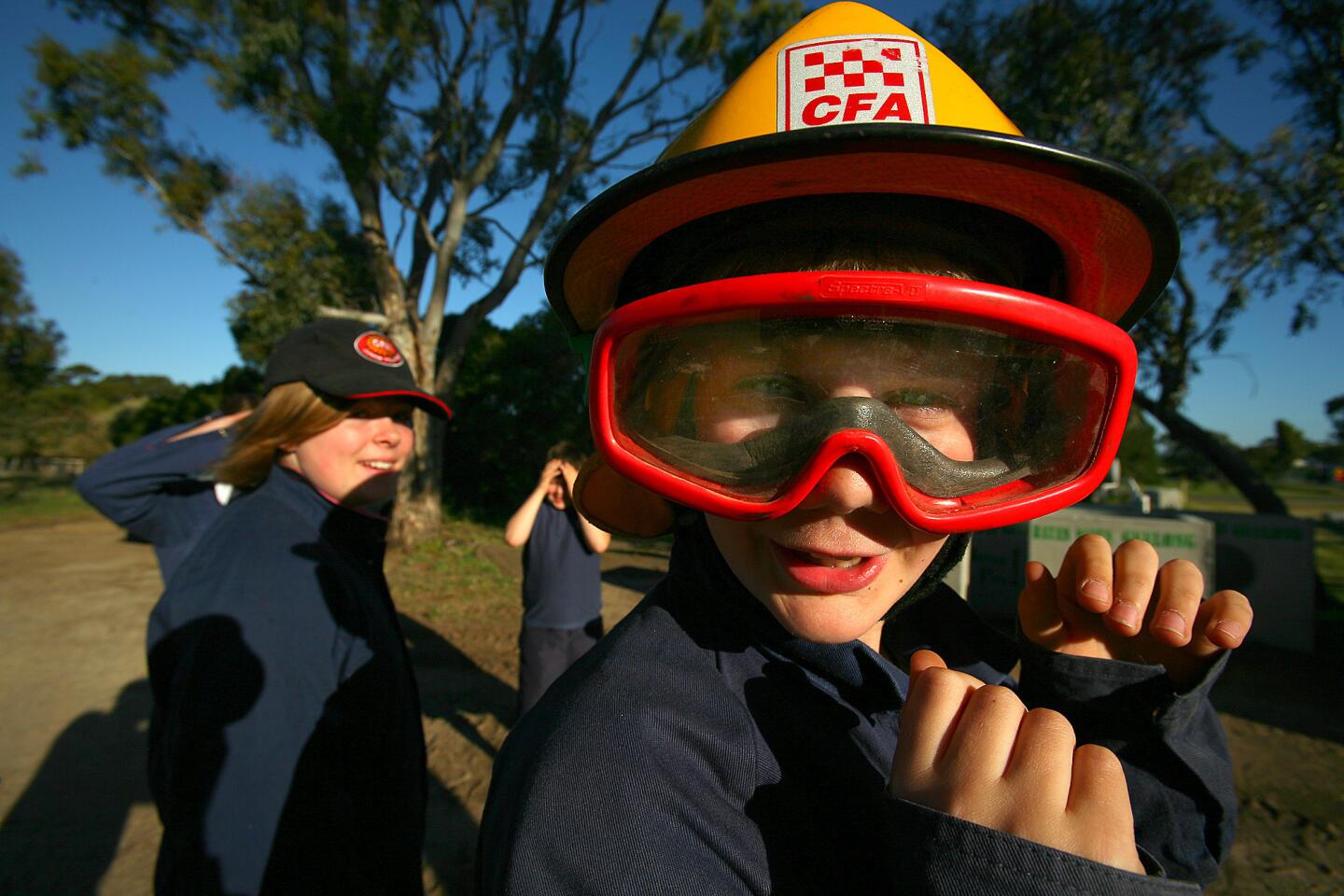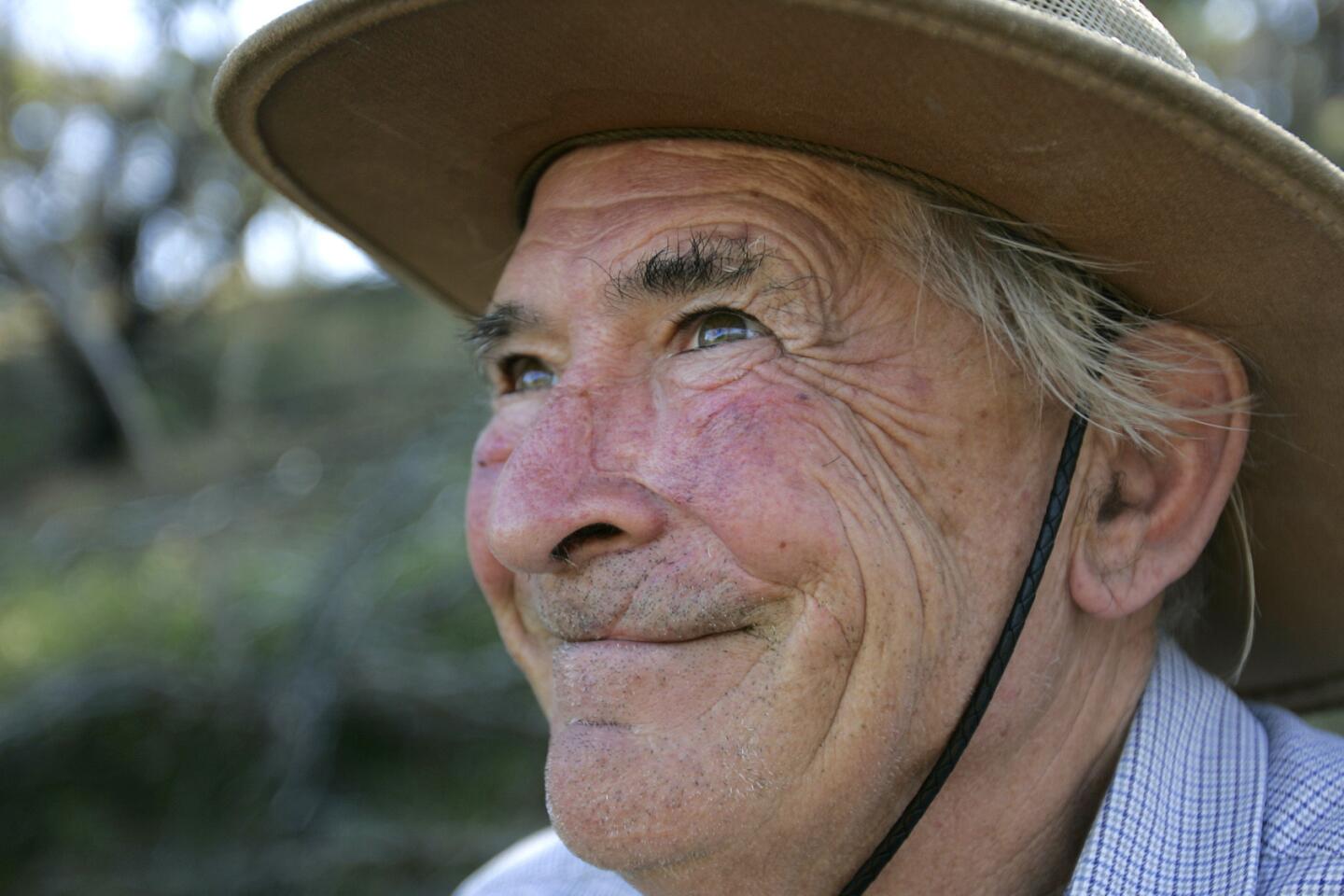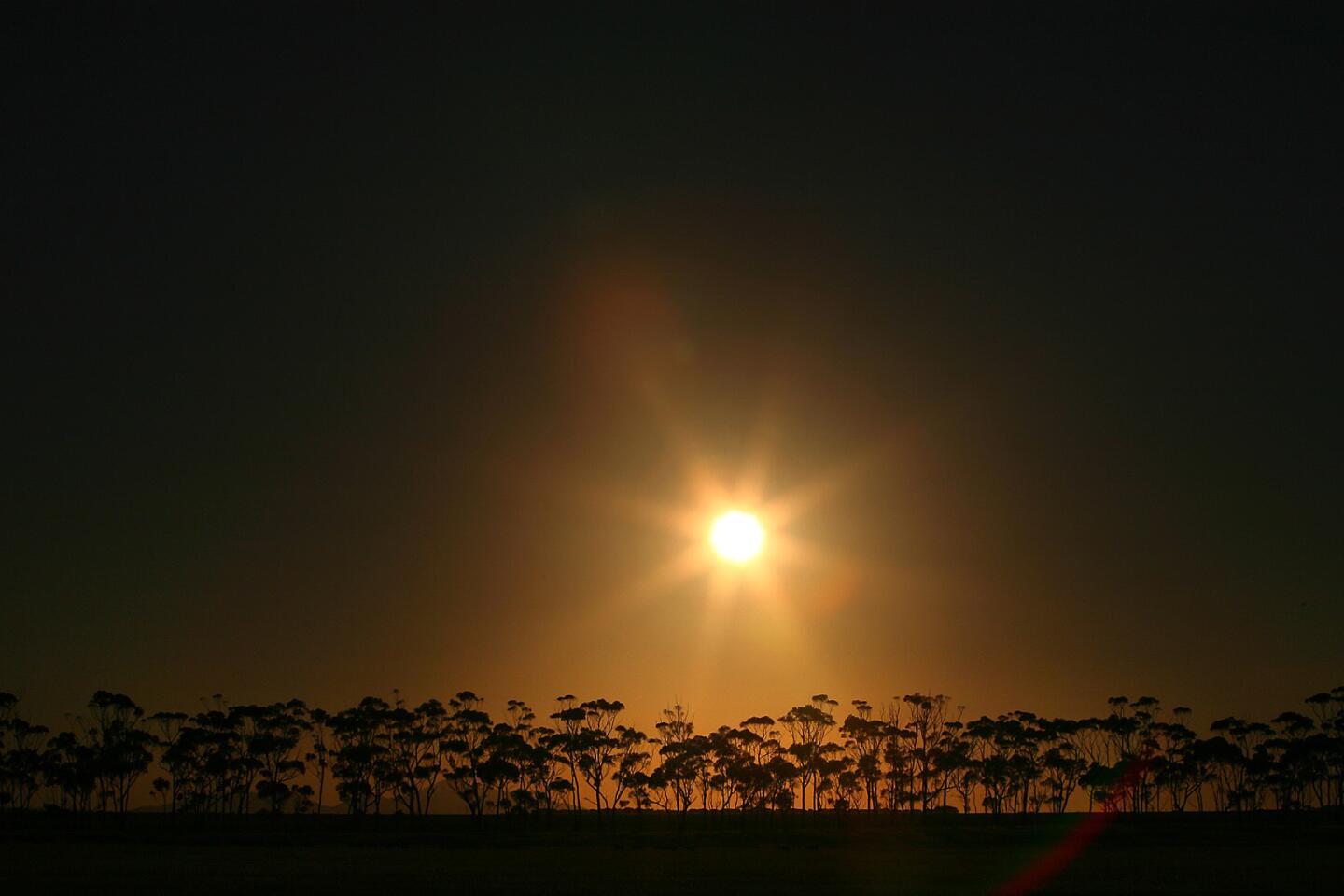‘Stay or go’ policy puts Australian families on front lines of firefighting
- Share via
ANAKIE, AUSTRALIA — It was brutally hot, 108 degrees, and the wind was howling. Bushfires were raging in the hills, making their way inexorably toward the Baker farmstead at the foot of the Brisbane Ranges.
John and Carlene Baker had moved here to get away from the hurly-burly of the city. They lived with their two children and a cast of orphaned animals on a 60-acre spread they called Foxford.
Now, all of it was threatened. Embers were falling around the house. The animals were growing restless. The Baker property sits deep in a box canyon, a mile from the main road. The couple knew there was little or no chance firefighters would reach them.
Southern Californians might respond to such a predicament by packing the car and evacuating. The thought never entered the Bakers’ minds. Instead, they did what they had been trained to do: stay and fight.
Fire is a pervasive danger in Australia, just as in much of the American West. But Australians cope with the threat in a manner difficult to envision in the U.S.
Americans expect firefighters to protect their lives and property. Australians in rural communities view that as their own responsibility.
U.S. authorities are quick to order mass evacuations during wildfires; they prefer to get civilians out of the way so professionals can douse the flames. Australian officials are more likely to hand homeowners shovels and put them to work.
People here live by the principle of “stay or go” during fire season. Residents who can’t or won’t battle an advancing fire are advised to get out early. Those who stay are expected to defend their homes. It’s a policy driven by pragmatism: There simply aren’t enough firefighters or firetrucks to protect far-flung rural homesteads.
What’s more, researchers here have found that people and houses are more likely to survive a bushfire if they stay together. The reason: Wind-borne embers and the spot fires they cause pose the greatest threat to homes. Residents properly trained and equipped can easily extinguish these small fires.
Fleeing at the last minute is much more dangerous than hunkering down and fighting. Roads are often choked with smoke or blocked by downed trees and utility poles. Late, panicky evacuations account for most wildfire deaths, Australian authorities have found.
The “stay or go” policy, adopted state by state beginning in the mid-1990s, has sharply reduced losses of life and property in wildfires, statistics show. In 1983, a year of widespread conflagrations, 60 Australians lost their lives in bushfires, not including firefighters, researcher Katharine Haynes reported. In the equally severe fire season of 2003, bushfires caused just six deaths.
Only a handful of Australians have died in their homes during wildfires in the last 10 years, and none of them were actively defending their properties, according to researchers at the Bushfire Cooperative Research Center in Melbourne.
There has also been a significant drop in fatalities among people who evacuate during bushfires, evidently because more of them are heeding advice to leave early, researchers say.
The “stay or go” approach so far has found little acceptance in the United States. But as wildfires become more severe and costlier to fight, some U.S. officials say the Australian model deserves a serious look.
“We need to push this concept and push it hard,” said Bodie Shaw, wildland fire director for the U.S. Bureau of Indian Affairs, which fights fires on reservations and other public lands. “The onus and responsibility need to shift to you as a property owner.”
Shaw is leading a group of federal, state and local fire officials examining how the Australian policy would work in this country. They will submit recommendations in the fall to the National Wildfire Coordinating Group, a Cabinet-level committee that reports to the president.
Rancho Santa Fe in northern San Diego County is one of the few communities outside Australia to adopt elements of “stay or go.” The local fire district urges homeowners to follow strict fire-safety standards for buildings and landscaping and stay in their homes during wildfires rather than evacuate in dangerous conditions. The policy stops short of training residents to actively defend their properties -- that’s still left to firefighters. Subdivisions totaling 5,000 homes are participating in the voluntary program.
In Australia, sheltering at home does not mean simply waiting the fire out. It means confronting the menace with hose, mop and shovel.
“Let’s be honest: It is scary,” said John Valcich, captain of a volunteer fire brigade in the rural community of Mansfield. “We’re not telling you that you have to stay. But [if you leave] you will lose your house. And don’t blame anyone. What’s it like to stay? It’s like standing at the back of a jet plane when it’s revving up. I try to tell people what to expect. But it comes as a hell of a shock when it hits.”
Living in a tinderbox
Australians, like Southern Californians, live in one of the world’s most combustible landscapes. Their native tree, the eucalyptus, litters the ground with kindling. Its oil-drenched leaves and bark ignite easily.
As in the Western U.S., Australians in growing numbers have been moving from cities and suburbs into picturesque but fire-prone scrublands. Making matters worse, the fire season has been starting earlier and lasting longer, a phenomenon attributed to prolonged drought and climate change.
The Bakers moved to the country 11 years ago from Geelong, a city of 240,000 near Melbourne. John, 45, who makes dental prosthetics, and Carlene, 43, who runs his office, had long dreamed of living in the bush. In Anakie, an hour’s drive west of Melbourne, they built a home in a deep valley surrounded by rocky hills and a forest of eucalyptus and wattle trees.
Soon after they arrived, the captain of the local fire brigade paid a visit and explained the philosophy of fire protection in these parts.
“He told us not to expect them to bring trucks up the drive and that we would be on our own,” Carlene recalled. “Then he asked us for a donation.”
The Bakers armed themselves against the danger. They stocked up on fire-resistant clothing. They bought a small pumper truck with regulation fire hoses and a generator to run water pumps. They set aside a 6,000-gallon water tank for fighting fires. They learned to clear brush regularly to create defensible space around the house. The entire family joined the volunteer fire brigade and received training through the state of Victoria’s rural fire service.
Their preparations were put to the test in early 2006, when bushfires marched across the region. The Bakers anxiously tracked the plumes of smoke. By Sunday, Jan. 22, they knew they were in for it. John’s parents took the family’s three horses to safety on their property near Melbourne. The children, Isaac, then 15, and Molly, 13, were given the option of leaving with them. They chose to stay. After securing the horses, the grandparents returned to help defend Foxford.
John moved tractors, two water trailers and other vehicles close to the house. Carlene, who takes in orphaned animals, made sure her charges were also within the family’s defensive perimeter, the rough circle of land they were determined to protect.
She shooed the hen and her newly hatched chicks into the house, where they shared a bathroom with two dogs. The cat, Midnight, spent the firestorm locked in a bedroom. An alpaca, five cows and 22 sheep remained in the barn, which Carlene declared must be defended at all costs.
Everyone was given a job. John and his father, Rodney, 69, repeatedly doused the house and outbuildings with water. Carlene and Isaac helped.
Inside, Molly and her grandmother, Pam, 66, filled the bathtub and sinks with water and soaked mops, towels and washcloths. They stuffed the towels under doors to keep out embers and smoke. They gave the washcloths to those outside to cover their mouths and wash ash and grime from their faces.
At 2 p.m., the Bakers got a call from neighbor Vaughan Stephens, a professional firefighter. Get ready, he told them. The fire is headed your way.
Embers the size of golf balls began to rain down. Each was a bomb that exploded on landing. “Within a minute, the flames were climbing up trees,” Carlene said. “We were completely surrounded by fire.”
For the next few hours, each family member protected an assigned area, extinguishing small fires with a hose or mop. Molly stuffed aluminum foil in the cracks between the stacked railroad ties that formed the front wall of the house. Carlene moved the pig from his frontyard pen onto the veranda to protect the animal from swirling embers.
By early evening, the ember attack had subsided. The house, barn and other buildings had survived -- so far. In the lull, Carlene noticed wildlife coming in from the bush. Wallabies and kangaroos crawled under the cars and farm equipment. Possums joined the pig on the veranda. The animals were taking shelter. The fire front was about to arrive.
‘A continent of fire’
Like those in Southern California, Australian bushfires are driven by wind. Hot, arid blasts out of the northwest rake the nation’s desert interior, hurtling toward Victoria’s eucalyptus forests and grasslands.
“Here reside the fires that give Australia its special notoriety, not merely as a continent of fire but as a place of vicious, unquenchable conflagrations,” American fire historian Stephen J. Pyne has written. “In the fire flume lurk the great, the irresistible fires of Australia.”
One of the worst blazes in the country’s recorded history occurred in February 1983. One hundred fires started on what came to be known as Ash Wednesday. Eighty-three people were killed, 2,600 injured and more than 2,500 homes destroyed in Victoria and South Australia.
The tragedy shook the nation and prompted governmental and academic inquiries. One study found that occupied houses survived at twice the rate of those left unattended. If the occupants were able-bodied, the survival rate for houses was 90%.
Teams of researchers interviewed survivors and compiled their recollections. A major finding: Most of those killed by the fires were in vehicles or out in the open. In one instance, a group overtaken on the road by a wall of flames huddled in their car as the windows exploded and the seats began to melt. One woman screamed that she couldn’t stand it any longer, then climbed out and ran for it. Her body was later found nearby, her rubber thongs fused to the blacktop.
Similar tragedies have occurred in Southern California. Nine people died fleeing the massive Cedar fire in San Diego County in October 2003.
In Australia, Ash Wednesday prompted a rethinking of fire preparedness. Federal researchers pored over more than 100 years of data recorded by rural fire brigades. Their findings dispelled a host of calcified myths, notably the belief that bushfires incinerated homes in a wall of flames. In fact, scientists concluded, more than 90% of the houses lost were never exposed to direct flames or radiant heat. Rather, structures typically were ignited by embers.
“That all instantly clicked with the fundamental observation that when people are around these structures, there’s a massive improvement in the statistical survivability of the house,” said fire researcher Justin Leonard. “It’s small, relatively insignificant ignitions that, in isolation, are relatively simple to put out. But you just have to be there at the time.”
Australia already had one of the world’s largest volunteer firefighting forces, but more people would need to be trained. Authorities developed community seminars, brochures and DVDs explaining how to maintain defensible space and prepare for an ember attack and then the fire.
A major challenge was persuading homeowners to overcome the primal impulse to flee in the face of fire.
“Where we’ve suffered the greatest loss of life is when people stay, then at the last minute go hopping in the car and ripping down the road, smashing into a tree at 100 miles an hour,” said Jim Darling, a volunteer firefighter who raises sheep and cattle in Strath Creek, 50 miles north of Melbourne.
“Panic is amazing. Put a lot of smoke on it and a dose of panic, and you’ve got people who drive a road every day of their lives losing their way and driving right off it.”
‘It sounded like a train’
At 7 p.m., Carlene Baker saw smoke flowing over the hills like lava. It was the leading edge of the fire.
At this stage in a bushfire, homeowners are trained to take shelter in their homes while the front passes over, which usually happens quickly. The couple knew that wouldn’t be the case this time.
High winds were whipping the fire around the bowl-shaped canyon. This front would not rush past; it would scour the landscape until there was nothing left to burn. The children and the grandparents were indoors, but Carlene and John would have to stay outside and fight.
A spot fire started behind the house. They rushed toward it before stopping short. They would have to drag hoses across a long stretch of burning ground, and dared not risk it.
A huge gum tree caught fire and exploded, then fell with a crash. A line of fire burst out of the debris and raced up the lawn, toward the house. Carlene and John made a stand, dousing the blaze with their fire hoses.
For four hours, they were in constant motion, dragging hoses from one fire to another. “Every direction was burning,” Carlene said. “You felt like you were melting.”
The wind picked up a wooden aviary, fluttering with colorful, fat budgerigars, and dashed it against the ground. Towering eucalyptus trees erupted in showers of sparks.
When John and Carlene had a chance, they banged on the front door. Molly would hand them wet washcloths and drinks, then snap the door shut. The heat was intense. So was the noise. “It sounded like a train going through,” Carlene said. When she needed to tell her husband something, she had to grab him by the shoulder to get his attention.
John had been racing around the compound putting out fires for hours. Near exhaustion, he told Carlene they should concentrate on saving the house and let everything else go. Carlene shouted: “No! We’re saving the animals.”
The couple laid down a misting rain in the barn to quell embers and smoke. Rosie, the Hereford cow, was terrified. “All I could see were the whites of her eyes,” Carlene said. “I stayed with her and patted her for a while.”
By 11 p.m., the front had moved on. The house had withstood the siege. Carlene and John kept an eye on embers that were glittering everywhere, but they knew they had taken the worst of it. They went inside to call neighbors and check in. They couldn’t: The phone line had melted.
The family members slept in shifts and patrolled the house and yard in pairs. Carlene and Molly, too wired to sleep, took the first shift. Sitting on the front veranda with the pig and possums, mother and daughter were treated to a spectacular show.
“In the pitch black, you could see the red glow everywhere,” Carlene said. “After all the roar of the fire, now there was no sound. It felt like you were the last people in the world.”
About 2 a.m., two dots of light appeared in the long driveway, distant and improbable. A truck skidded to a halt in the frontyard, and a man jumped out. It was their neighbor, Vaughan Stephens. He was crying.
He had come to check on the family and had found the front gates to the property lying charred on the ground. He’d continued up the driveway, telling himself: “Someone has to identify the bodies.” To his relief, they were all safe.
No regrets
Later that morning, they opened the front doors and the dogs bounded out of the house. Midnight the cat burned his paw digging in the still-hot ground. It was six months before he stepped outside again.
John and his parents went to work. Carlene and the children fashioned a makeshift corral for the animals; all the fences had burned. Neighbors and friends began to pour in. Carlene got a ride to a store to buy water and food and use the phone. On the way, she got her first good look at what the fire had done to Foxford’s rolling green hills.
“It was total devastation,” she said. “There were dead kangaroos everywhere, dead possums everywhere. I saw a lot of lumps that I couldn’t tell what they were. Turned out to be koalas.”
Still, the family counted itself lucky. Some neighbors and friends had lost everything.
Carlene kept reliving the choice she, John and the children had made to stay and fight. Had she known what it would be like, she might have evacuated. But having lived through the ordeal, Carlene said, she would do it again.
“We built that house ourselves. This is our home,” she said. “We’ll defend it again.”
More to Read
Sign up for Essential California
The most important California stories and recommendations in your inbox every morning.
You may occasionally receive promotional content from the Los Angeles Times.





















